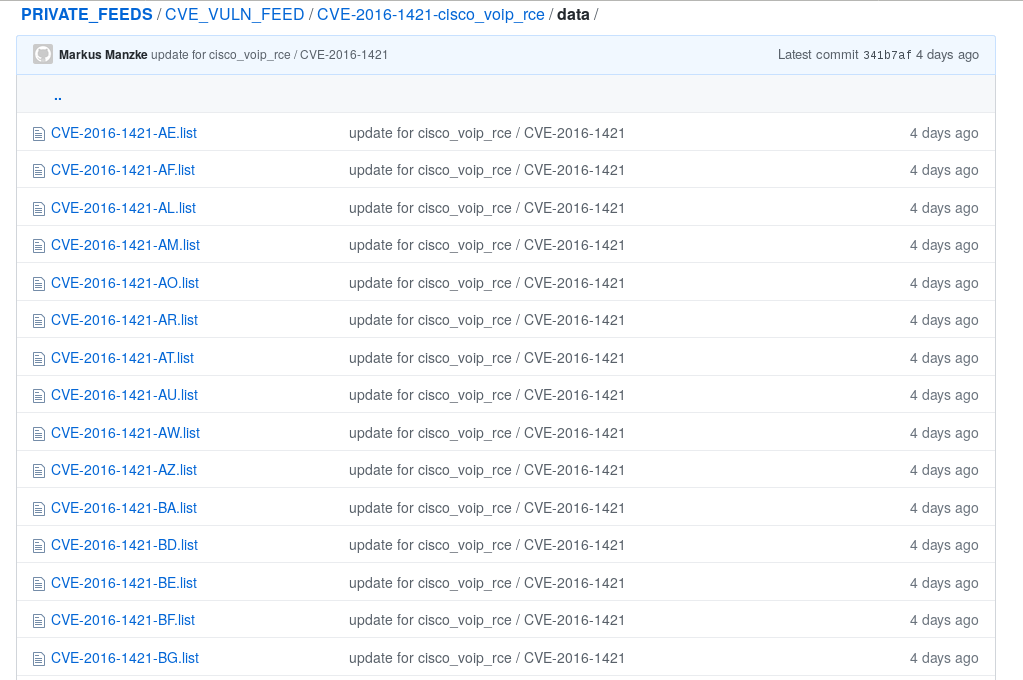Readme for COVID_CTI-League CVE_VULN_FEED
this is a short readme for the COVID-CTI-League CVE_VULN_FEED to be accessed from the outside.
Reference: Welcome to the CTI League
what it is
CVE_VULN_FEED is a Repo of critical vulns regarding internet-infrastructure, servers and services. there is one folder for each Vuln, and within this folder a data-dir, that keeps a list of IPs/AS-nr/AS-Description, seperated by country.
additionally, you might want to register for automated notification, based on AS-attribution (SOC) or Country-attribution (CERT)
what it does
whenever a critical vulnerability is published that matches the following criteria:
-
CVSS-Score >= 9
-
userInteraction == None
-
privilegesRequired == None
-
( confidentialityImpact == HIGH OR availabilityImpact == HIGH OR integrityImpact == HIGH)
-
attackVector == NETWORK
-
attackComplexity == (LOW OR MEDIUM)
which translates usually to RCE
or unauthorized Data-Access, or a 0-day or exploit_campaign going on,
we use super sophisticated cyber OSINT-methods to identify
servers and/or services that might fall into the category of beeing affected by the vuln/exploit.
we then extract the belonging IPs, check which country/as they are attributed, an generate country_based lists for easier access.
our baseline: that moment a CVE comes out or a 0day, all affected devices are to be considered possibly vulnerable. if we take a pure device/service-scan from the day bevore (pure OSINT) we have a list of targets
these method worked very well with recent vulns of technologgies like WebLogic/Liferay - Applicationservers, PulseVPN/Citrix/Netscaler-VPN-Gateways, and Exchange/OWA-Vulns. YMMV, but better safe than sorry, especially by internet-facing applications and appliances.
there are as well short helping-docs in each CVE-dir:
- Readme.md: a very brief description on what you might find (auto_generated)
- summary.md: a statistical breakdown by AS and Country (auto_generated)
- alert_text.md: a short notice about the vuln an links for further reference/analysis, also included in notifications
what it does NOT do
we do not, under any circumstances, make a vulnscan
basic principles
the assumption is: when a vuln/0day comes out, and we take data from that day or before, and we can say with a high confidentiality, that an exploit is not super-artificial, we assume that all found system from that day ore bevore are potentially vulnerable.
there is an article by Microsoft "Ransomware groups continue to target healthcare, critical services; here’s how to reduce risk", published in April 2020, that explains quite well the problem of an unamanged external attack_surface:
Vulnerable and unmonitored internet-facing systems provide easy access to human-operated attacks
VULN_ALERTS can definetly help ORGs patch faster and hopefully understand that concept of "external attack_surface". only if you understand this concept, you are able to minimize you attack_surface, thus be less vulnerable to external attacks and improve your overall security.
who might be interested
- National-Certs -> receive alerts from IPs in your Country
- PSIRT/SOC -> > receive alerts from Vulns and IPs in your AS
- Telcos/DC-Provider -> receive alerts from Vulns and IPs in your AS
notifications
- tbd
disclaimer
- since we do not make a full vuln_scan, the datasets can include False-Positive and exlcude False-Negatives
- GeoIP-Attribution might be wrong sometimes


